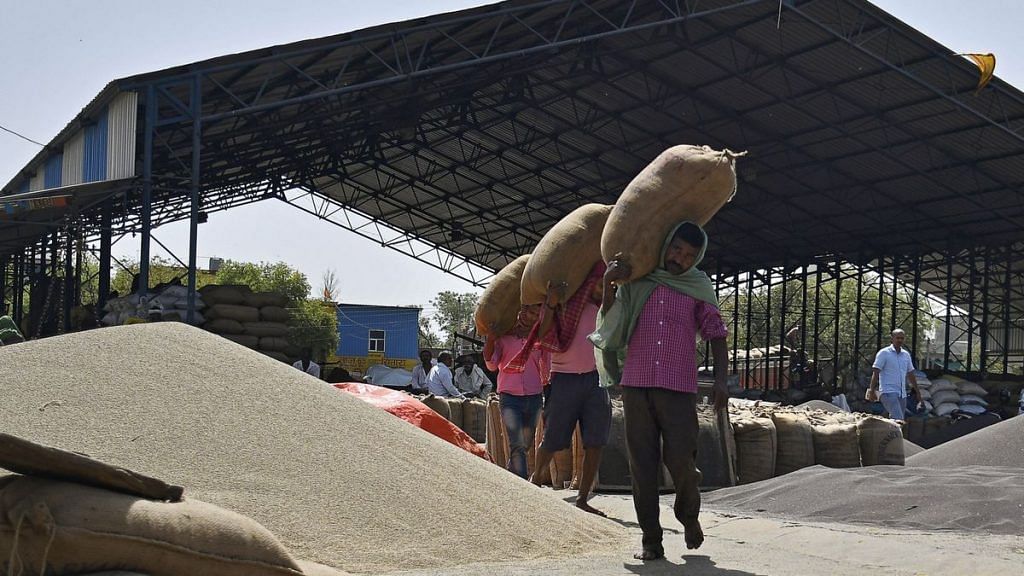Rising incomes over the last 50 years have changed what is eaten in the Indian thali. A typical thali now has less cereals and more vegetables, pulses, dairy and meat. But India’s food policy remains pro-cereal. The country devotes lakhs of crores for producing wheat and rice, and then tries to figure out how to store them, and get rid of them.
At the same time, prices of other food items on the thali go through sharp volatility. High prices and lower incomes seems to have led to reduction in the amounts of vegetable and pulses consumed in recent years.
India’s food policy has focused on cereals since the Green Revolution in the mid-1960s. But today, Indian food consumption baskets have changed significantly. Yet, agricultural policy continues to favour cereals, and the Food Corporation of India (FCI) buys millions of tons of wheat and rice at minimum support prices (MSP). As a consequence, farmers prefer to produce cereals. This has meant more than adequate supply. It is not a surprise that the prices of cereals have remained stable, while the prices of vegetables see wild swings.
Nutrition norms as well as rising household incomes should have pushed food production away from cereals to non-cereals. But owing to a pro-cereal policy, this has not happened. The supply of vegetables, milk and pulses in the country has not risen as it should have.
Farmers need price stability, which vegetables can’t provide
The key to what incentivises farmers lies in which prices are more stable. With subsidised inputs such as fertilisers, power and water and an assurance by the government to purchase output at the MSP, it is more attractive for farmers to produce wheat and rice than vegetables. They get more stable return.
Vegetable prices are volatile — recent consumer price index inflation has been mainly in vegetable prices. This happens every so often, when supply falls short. When prices are high and farmers produce a vegetable, then lots of them do so, and there is oversupply, leading to a crash in prices.
The whiplash in prices results in low farmer incomes. When prices are high, output is low, and so, income is inadequate. When output is high, prices crash, and therefore, income is inadequate. This makes vegetables less attractive than cereals. This keeps farmers away from shifting to vegetables, even though they are much higher value-added than cereals.
Also read: How Economic Survey used ‘Thalinomics’ to defend Modi govt’s inflation management
Spending on subsidies, procurement & storage doesn’t make sense
While the policy framework makes cereals attractive for an individual farmer, for the country as a whole, it is not the appropriate production basket. Spending lakhs of crores on cereal production through input subsidies, on procurement and then on storage, does not make sense any more.
While production of cereals has been rising, consumption has not. This has resulted in a rise in foodgrains stored. As of July 2019, a total of 744 lakh tonnes of foodgrain stocks were stored in godowns, open plinths and silos. India needs to hold, according to the buffer stock norm, only 411 lakh tonnes.
Today, just before the next crop, there is a crisis in states like Punjab. The 2018 stock has still not been sold from the godowns, and at least 2,000 tonnes of the 2018 wheat produce has been declared damaged. Now a bumper crop is expected — another 135 lakh tonnes in in the coming two months. The immediate problem is where to store it.
The food subsidy bill in 2019-20 was Rs 1.85 lakh crore. Most of it was spent on procuring wheat and rice at MSP and selling it at Rs 2 or 3 through the public distribution system to households.
In 2020-21, the subsidy bill will go up to Rs 2.1 lakh crore. The full subsidy is not being put on the Budget, and the FCI will borrow directly from the market as the food subsidy bill is increasingly becoming unaffordable. It is also clearly a suboptimal use of land, labour and water.
How the problem could be fixed
How can the country stop over-producing cereals and divert resources to other food items that people want to consume?
Some people suggest that the government should start procuring all other food products by bringing them under the MSP framework. That has two problems.
One, it is clearly unaffordable. The subsidy bill is already high. The government does not have enough facilities to store foodgrains. Even cereals, which are not very perishable, are rotting. It is hard to imagine what will happen if the government starts procuring vegetables, which are far more perishable.
Two, even if we assume that it was affordable, the bigger problem is that central planning is never as good as the invisible hand of the market. The government will choose a price for procurement. As in the case of cereals, it is not possible for central planners to adequately forecast demand and supply. The price chosen will lead farmers to produce a certain amount of a certain vegetable, and lead households to consume a certain amount. Will the two match?
The solution lies in both infrastructure and regulatory changes that wean the system away from cereals and allow a more diversified food basket to be produced. Vegetables, milk, meat, fish, eggs are more perishable. They require more infrastructural facilities like roads, cold storage chains, and access to markets. In addition, as the Economic Survey points out, the government needs to repeal the Essential Commodities Act, the APMC act and encourage free trade of food products.
The author is an economist and a professor at the National Institute of Public Finance and Policy. Views are personal.
Also read: High time Indian farmers are freed from shackles imposed by 1960s’ food-shortage mindset
